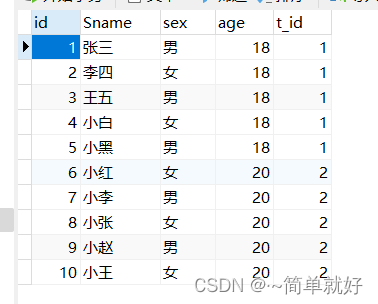Mybatis关联映射
·~简单就好 人气:0一、关联映射
举例关系说明
数据库创建表,student,teacher


关系说明:
- 一个老师可以有多个学生
- 一个学生只有一个老师
- 一个老师对学生:一对多的关系
- 一个学生老师:一对一的关系
二、一对一多对一的关系
查询学生信息及其对应的教师信息
学生实体:用对象来存储教师信息,因为一个学生对应一个教师对象
public class Student {
private Integer id;
private String Sname;
private String sex;
private Integer age;
private Integer t_id;
//这个是重点
private Teacher teacher;
}
教师实体:
public class Teacher {
private Integer id;
private String Tname;
}
1.第一种形式-连表查询
数据库查询sql:
SELECT student.id,student.name,teacher.name FROM student LEFT JOIN teacher on student.t_id = teacher.id
mybatis多表联查查询语句:(嵌套其他实体对象)
对于特殊数据:
- 如果是对象:用association :< association property=“teacher” javaType=“com.qcby.entity.Teacher”>,特殊数据特殊处理
- < result property=“id” column=“id”/> :所要查询的字段,property代表java中实体的属性名称,column:表示数据库的字段
<!-- 按照结果嵌套处理-->
<select id="getStudent1" resultMap="StudentTeacher1">
SELECT student.id,student.Sname,teacher.Tname FROM student LEFT JOIN teacher on student.t_id = teacher.id
</select>
<resultMap id="StudentTeacher1" type="com.qcby.entity.Student">
<result property="id" column="id"/>
<result property="Sname" column="Sname"/>
<result property="sex" column="sex"/>
<result property="age" column="age"/>
<result property="t_id" column="t_id"/>
<!-- 复杂的属性我们需要单独去处理 对象:association 集合:collection -->
<!-- property="teacher" student类当中的关联字段 -->
<!-- javaType="com.javen.model.Teacher" 为复杂属性设置类类型-->
<association property="teacher" javaType="com.qcby.entity.Teacher">
<result property="id" column="id"/>
<result property="Tname" column="Tname"/>
</association>
</resultMap>
2.第二种形式-分步查询
数据库查询sql:
SELECT s.id,s.Sname,t.Tname FROM student s,teacher t where s.t_id = t.id
mybatis分布查询查询语句:
<select id = "getStudent" resultMap="StudentTeacher">
select * from student;
</select>
<!--结果映射集-->
<resultMap id="StudentTeacher" type="com.qcby.entity.Student">
<result property="id" column="id"/>
<result property="Sname" column="Sname"/>
<result property="sex" column="sex"/>
<result property="age" column="age"/>
<result property="t_id" column="t_id"/>
<!-- select="getTeacher" :调用下一个查询语句 -->
<!-- column="t_id" 两个表的关联字段-->
<association property="teacher" column="t_id" javaType="com.qcby.entity.Teacher" select="getTeacher"/>
</resultMap>
<select id="getTeacher" resultType="com.qcby.entity.Teacher">
select * from teacher where id = #{t_id}; <!-- #{id}; 可以写任何东西,因为会自动匹配 t_id -->
</select>三、一对多
查询教师对应的学生信息
设立教师实体:用集合来存储对应的学生信息,因为一个教师对应多个学生
public class Teacher {
private Integer id;
private String Tname;
//这个一定要有
private List<Student> students;
}
第一种形式按照结果嵌套处理
mybatis查询语句:
<!--按照结果进行查询-->
<select id="getTeacher" resultMap="TeacherStudent">
SELECT teacher.id,teacher.Tname,student.Sname FROM teacher
LEFT JOIN student on student.t_id = teacher.id
</select>
<resultMap id="TeacherStudent" type="com.qcby.entity.Teacher">
<result property="id" column="id"/>
<result property="Tname" column="Tname"/>
<!-- 复杂的属性我么需要单独去处理 对象:association 集合:collection
在集合中的泛型信息,我们使用ofType获取
-->
<collection property="students" ofType="com.qcby.entity.Student">
<!-- 查询什么写什么 -->
<result property="Sname" column="Sname"/>
</collection>
</resultMap>
第二种形式按照查询嵌套处理
mybatis查询语句: 对于特殊字段集合采用分布查询的方式,特殊字段特殊处理:< collection property=“students” column=“t_id”
ofType=“com.qcby.entity.Student” select=“getStudentByTeacherId” />,getStudentByTeacherId一个新的查询语句
<!--按照查询嵌套处理:分布查询-->
<select id="getTeacher" resultMap="TeacherStudent2">
select * from teacher
</select>
<resultMap id="TeacherStudent2" type="com.qcby.entity.Teacher">
<!--column="t_id" 传值-->
<collection property="students" column="t_id"
ofType="com.qcby.entity.Student" select="getStudentByTeacherId" /> <!--实现分布查询-->
</resultMap>
<select id="getStudentByTeacherId" resultType="com.qcby.entity.Student">
select * from student where id = #{t_id}
</select加载全部内容